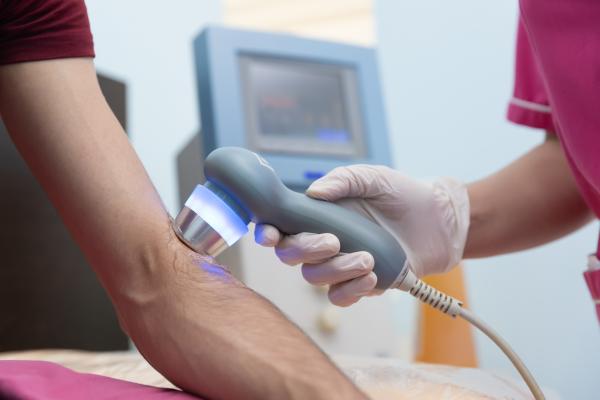Arthritis

Arthritis is a term often used to mean any disorder that affects joints. Symptoms generally include joint pain and stiffness. Other symptoms may include redness, warmth, swelling, and decreased range of motion of the affected joints. In some types of arthritis, other organs are also affected. Onset can be gradual or sudden.
There are over 100 types of arthritis. The most common forms are osteoarthritis (degenerative joint disease) and rheumatoid arthritis. Osteoarthritis usually occurs with age and affects the fingers, knees, and hips. Rheumatoid arthritis is an autoimmune disorder that often affects the hands and feet. Other types include gout, lupus, fibromyalgia, and septic arthritis. They are all types of rheumatic disease.
Treatment may include resting the joint and alternating between applying ice and heat. Weight loss and exercise may also be useful. Recommended medications may depend on the form of arthritis. These may include pain medications such as ibuprofen and paracetamol (acetaminophen). In some circumstances, a joint replacement may be useful.
Osteoarthritis affects more than 3.8% of people, while rheumatoid arthritis affects about 0.24% of people. Gout affects about 1–2% of the Western population at some point in their lives. In Australia about 15% of people are affected by arthritis, while in the United States more than 20% have a type of arthritis. Overall the disease becomes more common with age. Arthritis is a common reason that people miss work and can result in a decreased quality of life. The term is derived from "arthr"- (meaning 'joint') and -"itis" (meaning 'inflammation').
Inability to use the hand or walk
Stiffness in one or more joints
Rash or itch
Malaise and fatigue
Weight loss
Poor sleep
Muscle aches and pains
Tenderness
Difficulty moving the joint
It is common in advanced arthritis for significant secondary changes to occur. For example, arthritic symptoms might make it difficult for a person to move around and/or exercise, which can lead to secondary effects, such as:
It is estimated that the total cost of arthritis cases is close to $100 billion of which almost 50% is from lost earnings. Each year, arthritis results in nearly 1 million hospitalizations and close to 45 million outpatient visits to health care centers.
Decreased mobility, in combination with the above symptoms, can make it difficult for an individual to remain physically active, contributing to an increased risk of obesity, high cholesterol or vulnerability to heart disease. People with arthritis are also at increased risk of depression, which may be a response to numerous factors, including fear of worsening symptoms.
Elements of the history of the disorder guide diagnosis. Important features are speed and time of onset, pattern of joint involvement, symmetry of symptoms, early morning stiffness, tenderness, gelling or locking with inactivity, aggravating and relieving factors, and other systemic symptoms. Physical examination may confirm the diagnosis, or may indicate systemic disease. Radiographs are often used to follow progression or help assess severity.
Blood tests and X-rays of the affected joints often are performed to make the diagnosis. Screening blood tests are indicated if certain arthritis are suspected. These might include: rheumatoid factor, antinuclear factor (ANF), extractable nuclear antigen, and specific antibodies.
Bone erosion is a central feature of rheumatoid arthritis. Bone continuously undergoes remodeling by actions of bone resorbing osteoclasts and bone forming osteoblasts. One of the main triggers of bone erosion in the joints in rheumatoid arthritis is inflammation of the synovium, caused in part by the production of pro-inflammatory cytokines and receptor activator of nuclear factor kappa B ligand (RANKL), a cell surface protein present in Th17 cells and osteoblasts. Osteoclast activity can be directly induced by osteoblasts through the RANK/RANKL mechanism.
Psoriasis can develop into psoriatic arthritis. With psoriatic arthritis, most individuals develop the skin problem first and then the arthritis. The typical features are of continuous joint pains, stiffness and swelling. The disease does recur with periods of remission but there is no cure for the disorder. A small percentage develop a severe painful and destructive form of arthritis which destroys the small joints in the hands and can lead to permanent disability and loss of hand function.
How is Naftalan Arthritis Treated? What physiotherapy devices are used and how?
Every guest who is admitted to the Gashalti Health Hotel Naftalan with a diagnosis of Arthritis is examined and receives the following treatments:
•General blood analysis
•General urine analysis
•Determination of blood sugar (Glucose)
•Cholesterol
•ALT
•AST
•Creatinine
•ECG examination
•Complete ultrasound examination
•Examination by doctors (Therapist, Gynecologist, Urologist, Nutritionist, Cardiologist, Neuropathologist, Dermatologist)
Treatment:
•Naftalan baths (As an alternative treatment for contraindications Iodine-bromine bath)
•Electrophoresis
•Quartz therapy
•Ultrasound therapy
Individuals with arthritis can benefit from both physical and occupational therapy. In arthritis the joints become stiff and the range of movement can be limited. Physical therapy has been shown to significantly improve function, decrease pain, and delay need for surgical intervention in advanced cases. Exercise prescribed by a physical therapist has been shown to be more effective than medications in treating osteoarthritis of the knee. Exercise often focuses on improving muscle strength, endurance and flexibility. In some cases, exercises may be designed to train balance. Occupational therapy can provide assistance with activities. Assistive technology is a tool used to aid a person's disability by reducing their physical barriers by improving the use of their damaged body part, typically after an amputation. Assistive technology devices can be customized to the patient or bought commercially.
Depending on the type of arthritis, the medications that are given may be different. For example, the first-line treatment for osteoarthritis is acetaminophen (paracetamol) while for inflammatory arthritis it involves non-steroidal anti-inflammatory drugs (NSAIDs) like ibuprofen. Opioids and NSAIDs may be less well tolerated. However, topical NSAIDs may have better safety profiles than oral NSAIDs. For more severe cases of osteoarthritis, intra-articular corticosteroid injections may also be considered.
The drugs to treat rheumatoid arthritis (RA) range from corticosteroids to monoclonal antibodies given intravenously. Due to the autoimmune nature of RA, treatments may include not only pain medications and anti-inflammatory drugs, but also another category of drugs called disease-modifying antirheumatic drugs (DMARDs). Treatment with DMARDs is designed to slow down the progression of RA by initiating an adaptive immune response, in part by CD4+ T helper (Th) cells, specifically Th17 cells. Th17 cells are present in higher quantities at the site of bone destruction in joints and produce inflammatory cytokines associated with inflammation, such as interleukin-17 (IL-17).
Low level laser therapy may be considered for relief of pain and stiffness associated with arthritis. Evidence of benefit is tentative.
Pulsed electromagnetic field therapy (PEMFT) has tentative evidence supporting improved functioning but no evidence of improved pain in osteoarthritis. The FDA has not approved PEMFT for the treatment of arthritis. In Canada, PEMF devices are legally licensed by Health Canada for the treatment of pain associated with arthritic conditions.
Disability due to musculoskeletal disorders increased by 45% from 1990 to 2010. Of these, osteoarthritis is the fastest increasing major health condition. Among the many reports on the increased prevalence of musculoskeletal conditions, data from Africa are lacking and underestimated. A systematic review assessed the prevalence of arthritis in Africa and included twenty population-based and seven hospital-based studies. The majority of studies, twelve, were from South Africa. Nine studies were well-conducted, eleven studies were of moderate quality, and seven studies were conducted poorly. The results of the systematic review were as follows:
•Rheumatoid arthritis: 0.1% in Algeria (urban setting); 0.6% in Democratic Republic of Congo (urban setting); 2.5% and 0.07% in urban and rural settings in South Africa respectively; 0.3% in Egypt (rural setting), 0.4% in Lesotho (rural setting)
• Osteoarthritis: 55.1% in South Africa (urban setting); ranged from 29.5 to 82.7% in South Africans aged 65 years and older
•Knee osteoarthritis has the highest prevalence from all types of osteoarthritis, with 33.1% in rural South Africa
•Ankylosing spondylitis: 0.1% in South Africa (rural setting)
•Psoriatic arthritis: 4.4% in South Africa (urban setting)
•Gout: 0.7% in South Africa (urban setting)
•Juvenile idiopathic arthritis: 0.3% in Egypt (urban setting)
In 1715, William Musgrave published the second edition of his most important medical work, De arthritide symptomatica, which concerned arthritis and its effects. Augustin Jacob Landré-Beauvais, a 28-year-old resident physician at Saltpêtrière Asylum in France was the first person to describe the symptoms of rheumatoid arthritis. Though Landré-Beauvais' classification of rheumatoid arthritis as a relative of gout was inaccurate, his dissertation encouraged others to further study the disease.
